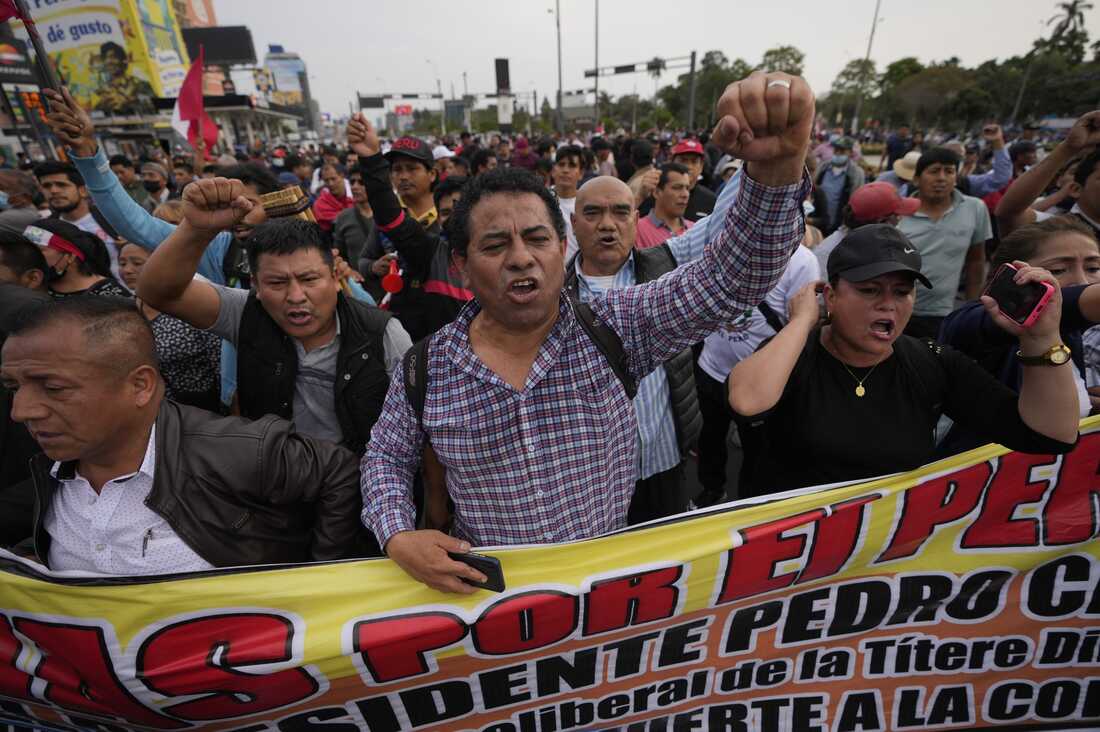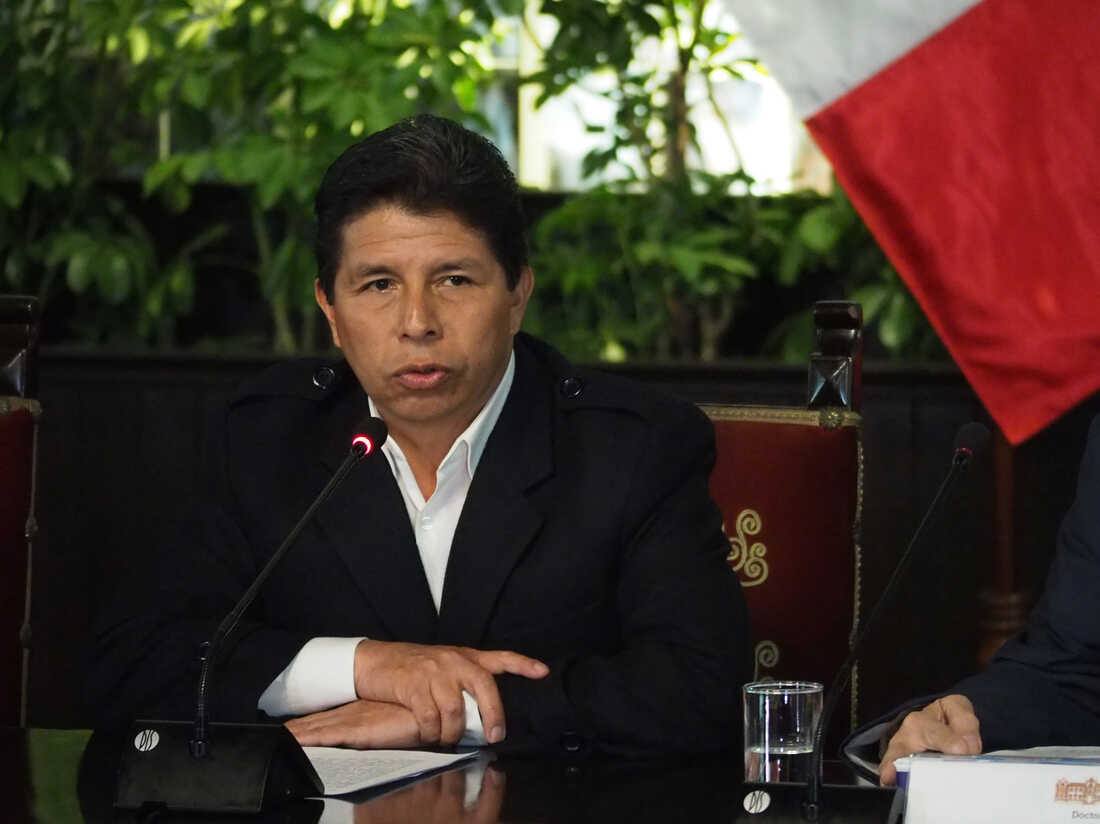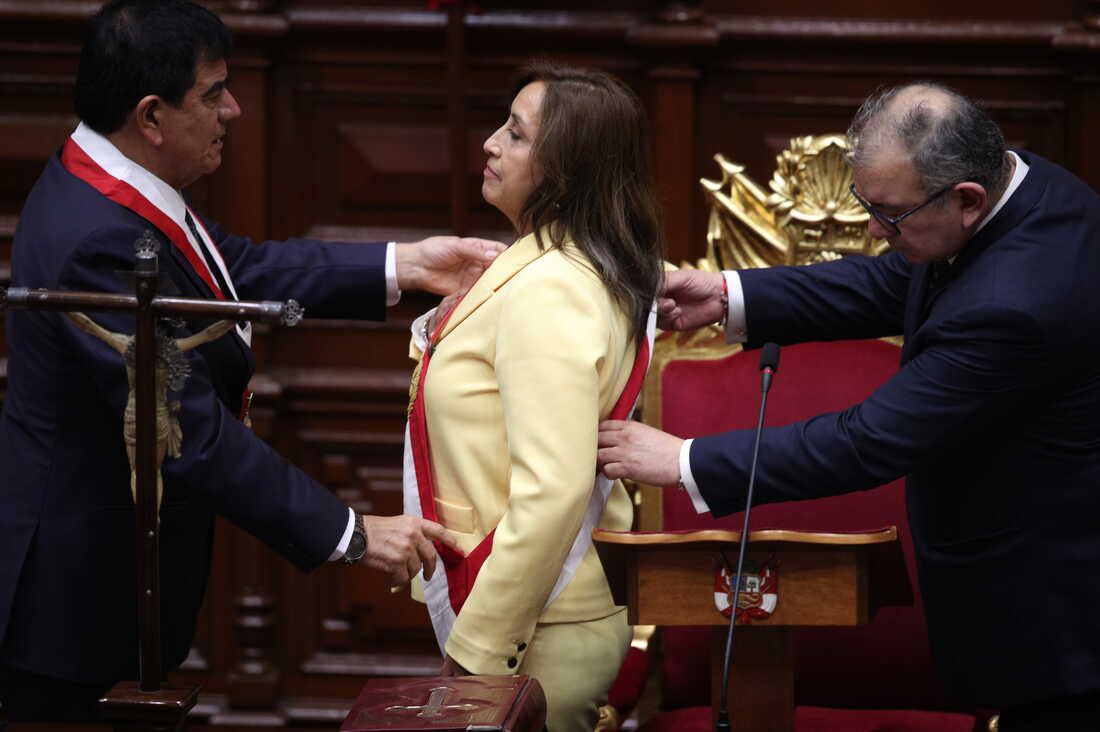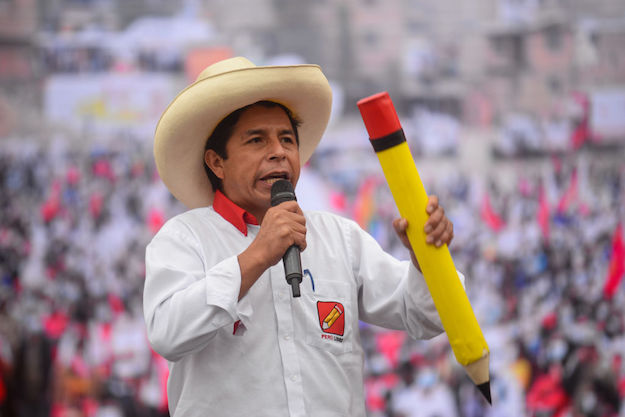December 9, 2022
Heard on All Things Considered
SIMEON TEGEL, NPR
Transcript

Supporters of ousted Peruvian President Pedro Castillo march at the Plaza San Martin in Lima, Peru on Thursday. Peru's Congress voted to remove Castillo from office Wednesday and replace him with the vice president, Dina Boluarte, shortly after Castillo tried to dissolve the legislature ahead of a scheduled vote to remove him.
LIMA, Peru — Perhaps the most telling detail of Pedro Castillo's botched coup attempt this week was the fact that the high-stakes gamble may have been completely unnecessary.
The now former president of Peru made his power grab during an abrupt televised address to the nation on Wednesday morning in which he announced that he was shuttering Congress, "reorganizing" the judiciary and would rule by decree.
He had no constitutional authority to do so and, as swiftly became clear, zero support from the armed forces.
The chaos of Castillo
The move was intended to preempt an impeachment debate on corruption charges scheduled for that afternoon. Had that debate gone ahead as scheduled, many here still doubt that Castillo, 53, a former rural schoolteacher and wildcat strike leader, would have actually been ousted.

Peruvian President Pedro Castillo at a press conference for foreign journalists in Lima on Oct. 11.
Since he took office in July 2021, Castillo's administration has been a chaotic mess of far left infighting, endless corruption scandals and ineptitude.
All the while, the president largely ignored the poor who he frequently claimed to represent.
The result is that lawmakers had already twice tried to impeach him but on each occasion failed to reach the required two-thirds supermajority. Based on the frantic vote counting on Wednesday morning, that scenario appeared likely to repeat itself.

Opposers to Peruvian President Pedro Castillo protest outside the Lima Prefecture on Wednesday.
From traffic gridlock - to prison
But Castillo's address to the nation, his hands visibly trembling as he clutched the sheet of paper on which his speech was written, changed the calculus.
The power grab was so flagrant that many members of Congress who had previously backed the erratic political novice, felt they had no choice but to vote to remove him. The impeachment debate was moved forward on an emergency basis and Castillo was ousted by 101 votes to six just under two hours after he had made his dramatic TV appearance.

Peruvian congress members pose for a picture after the vote for the impeachment of President Pedro Castillo in Lima on Wednesday.
That then followed a brief period of uncertainty over the now ex-president's whereabouts, until it emerged that his SUV had become stuck in Lima's frequently gridlocked traffic on its way to the Mexican Embassy, where Castillo had been planning to request asylum.
He appeared in court for the first time on Thursday, looking glum after spending his first night in the cells. The judges rejected his attorney's habeas corpus request and ordered the ex-president be kept in preliminary detention for another week.
Peru's new President

President of Congress Jose Williams, left, and Sen. Jose Cevasco, right, place the presidential sash on Vice President Dina Boluarte as she is sworn-in as the country's new president in Lima on Wednesday. Boluarte replaced ousted President Pedro Castillo and became the first female leader in the history of the republic.
Castillo's Vice President, Dina Boluarte, was swiftly sworn in to take his place. She also hails from his self-declared Marxist-Leninist Free Peru party but has managed to steer clear of his endless corruption scandals while also distancing herself from the beleaguered leader in recent months.
Also a political neophyte, it remains unclear whether the 60-year-old lawyer has the political skills to build a legislative alliance within the conservative-dominated Congress and bring the Andean nation's six years of political turmoil to an end.
But Boluarte appears better qualified than Castillo — who faces half a dozen different corruption investigations, including one for allegedly falsifying his master's thesis — and should at least get a honeymoon period of several months.
Democracy tested - and survived

People clash with riot police during a demonstration demanding the release of ex-President Pedro Castillo and the closure of the Peruvian Congress in Lima on Thursday, a day after Castillo's impeachment.
The other piece of good news for Peru is that despite being tested almost to its limits, the country's democratic institutions have survived this latest assault.
There have been only small protests and violence in the streets and most citizens appear to understand that, although lawmakers' motives in seeking to oust Castillo may have been, in part, self-serving, ultimately the president simply had to go.
Maybe, just maybe, the new government and Congress will finally find some common ground in addressing ordinary Peruvians' numerous serious challenges, from endemic food insecurity to the social fallout from the pandemic in a society which has had the highest Covid 19 mortality in the world.

Peru’s Oligarchy Overthrows President Castillo – OpEd
June 6, 2021, was a day which shocked many in Peru’s oligarchy. Pedro Castillo Terrones, a rural schoolteacher who had never before been elected to office, won the second round of the presidential election with just over 50.13% of the vote. More than 8.8 million people voted for Castillo’s program of profound social reforms and the promise of a new constitution against the far-right’s candidate, Keiko Fujimori. In a dramatic turn of events, the historical agenda of neoliberalism and repression, passed down by former Peruvian dictator Alberto Fujimori to his daughter Keiko, was rejected at the polls.
From that day on, still in disbelief, the Peruvian oligarchy declared war on Castillo. They made the next 18 months for the new president a period of great hostility as they sought to destabilize his government with a multi-pronged attack that included significant use of lawfare. With a call to “throw out communism,” plans were made by the oligarchy’s leading business group, the National Society of Industries, to make the country ungovernable under Castillo.
In October 2021, recordings were released that revealed that since June 2021, this group of industrialists, along with other members of Peru’s elite and leaders of the right-wing opposition parties, had been planning a series of actions including financing protests and strikes. Groups of former military personnel, allied with far-right politicians like Fujimori, began to openly call for the violent overthrow of Castillo, threatening government officials and left-leaning journalists.
The right-wing in Congress also joined in these plans and attempted to impeach Castillo on two occasions during his first year in office. “Since my inauguration as president, the political sector has not accepted the electoral victory that the Peruvian people gave us,” Castillo said in March 2022. “I understand the power of Congress to exercise oversight and political control, however, these mechanisms cannot be exercised by mediating the abuse of the right, proscribed in the constitution, ignoring the popular will expressed at the polls,” he stressed. It turns out that several of these lawmakers, with support from a right-wing German foundation, had also been meeting regarding how to modify the constitution to quickly remove Castillo from office.
The oligarchic rulers of Peru could never accept that a rural schoolteacher and peasant leader could be brought into office by millions of poor, Black, and Indigenous people who saw their hope for a better future in Castillo. However, in the face of these attacks, Castillo became more and more distanced from his political base. Castillo formed four different cabinets to appease the business sectors, each time conceding to right-wing demands to remove leftist ministers who challenged the status quo. He broke with his party Peru Libre when openly challenged by its leaders. He sought help from the already discredited Organization of American States in looking for political solutions instead of mobilizing the country’s major peasant and Indigenous movements. By the end, Castillo was fighting alone, without support from the masses or the Peruvian left parties.
The final crisis for Castillo broke out on December 7, 2022. Weakened by months of corruption allegations, left infighting, and multiple attempts to criminalize him, Castillo was finally overthrown and imprisoned. He was replaced by his vice president, Dina Boluarte, who was sworn in after Congress impeached Castillo with 101 votes in favor, six against, and ten abstentions.
The vote came hours after he announced on television to the country that Castillo was dissolving Congress. He did so preemptively, three hours before the start of the congressional session in which a motion to dismiss him for “permanent moral incapacity” was to be debated and voted on due to allegations of corruption that are under investigation. Castillo also announced the start of an “exceptional emergency government” and the convening of a Constituent Assembly within nine months. He said that until the Constituent Assembly was installed, he would rule by decree. In his last message as president, he also decreed a curfew to begin at 10 o’clock that night. The curfew, as well as his other measures, was never applied. Hours later, Castillo was overthrown.
Boluarte was sworn in by Congress as Castillo was detained at a police station. A few demonstrations broke out in the capital Lima, but nowhere near large enough to reverse the coup which was nearly a year and a half in the making, the latest in Latin America’s long history of violence against radical transformations.
The coup against Pedro Castillo is a major setback for the current wave of progressive governments in Latin America and the people’s movements that elected them. This coup and the arrest of Castillo are stark reminders that the ruling elites of Latin America will not concede any power without a bitter fight to the end. And now that the dust has settled, the only winners are the Peruvian oligarchy and their friends in Washington.
Manolo De Los Santos is the co-executive director of the People’s Forum and is a researcher at Tricontinental: Institute for Social Research. He co-edited, most recently, Viviremos: Venezuela vs. Hybrid War (LeftWord Books/1804 Books, 2020) and Comrade of the Revolution: Selected Speeches of Fidel Castro (LeftWord Books/1804 Books, 2021). He is a co-coordinator of the People’s Summit for Democracy.
This article was produced by Globetrotter.
Peru's President Pedro Castillo. Credit: ANDINA/Prensa Presidencia.
Democracy
A Socially Conservative Left Is Gaining Traction in Latin America

It’s no secret that the Latin American left has a strongman problem. From Havana to Caracas to Managua, self-proclaimed socialists are notorious for taking office only to never step down. But while left-wing autocrats and their human rights abuses garner much media attention, an emerging crop of leftist politicians in Latin America poses a more insidious threat: they’re embracing regressive social values. If they continue to fail in elevating the causes of equality, diversity and individual freedom, the new leaders on the left will leave the region’s most vulnerable and underrepresented communities at great risk.
Socially progressive causes began to lose their luster in the mid-2010s, especially as evangelical groups with hardline stances on abortion and LGBTQ rights – and equipped with mega-churches – expanded as a voting bloc. Right-wing politicians like Brazil’s Jair Bolsonaro swept back into office, styling themselves as defenders of “traditional family values.” Donald Trump proved a convincing example to follow.
Now, after years spent championing the cause of women and minorities, Latin American leftists have veered to the right on social issues, leaning into traditionally conservative positions on gender equality, abortion access, LGBTQ rights, immigration, and the environment. The left’s conservative turn leaves marginalized communities bereft of their traditional political allies and jeopardizes freedom and safety. And if an economically populist yet socially conservative platform continues to prove a winning electoral formula, as it did earlier this month in Peru, regionwide poverty relief may ultimately come at the cost of individual rights.
On the gender equality front, evidence of this shift is everywhere. Mexico’s President Andrés Manuel López Obrador campaigned on rectifying the gender pay gap and gender-based violence. But rather than meeting with women protesting the country’s record-setting levels of femicide, López Obrador shut out the protesters’ chants by erecting a ten-foot-high wall around the presidential palace.
Peru’s new socialist president-elect, Pedro Castillo, chalked up his country’s femicide problem to male “idleness,” blasting what he calls “gender ideology” taught in Peruvian schools. And Ecuador, governed by leftist administrations for most of the last two decades, has among the strictest anti-abortion laws in the world. Rafael Correa, in office from 2007 to 2017, even pressured his own party to keep the abortion ban in place.
Despite the expansion of LGBTQ rights during a wave of left and center-left presidents in the early 2000s, these communities have fared poorly under some on the left.
While strongmen like Nicolás Maduro have never been shy about using homophobia for political gain, the Dominican Republic’s “social democrat” president, Luis Abinader, disappointed activists when he publicly rejected same-sex marriage protections under considerable pressure from religious leaders; he, too, has backtracked on liberalizing abortion access. El Salvador’s populist president, Nayib Bukele, who started his career on the political left as mayor of the country’s capital and once declared himself an “ally” to LGBTQ people, has since come out against marriage equality and stopped his government’s sexual diversity work.
Around the world, xenophobia against immigrants is often the calling card of the radical right. In Latin America, the inverse is sometimes true. López Obrador has militarized Mexico’s southern border, deploying tear gas and rubber bullets against Central American migrant caravans. Peru’s Castillo insists that undocumented migrants will be given 72 hours to flee the country after he takes office. And Argentina’s leftist president recently sparked outrage with his remark that “Brazilians emerged from the jungle but we Argentines arrived on boats. On boats from Europe.”
In Latin America, environmental policy is also a social issue because the costs of climate change land heavily on ethnic and racial minorities. Leftist politicians – who often rely on natural resources to achieve their priority of redistributing wealth – have all too frequently sided against the environment and its defenders in the process.
In Ecuador’s April election, progressive presidential candidate Andrés Arauz – who narrowly lost – dug in his heels on oil drilling in the Amazon over loud objections by indigenous groups. Bolivia’s socialist President Luis Arce, too, was chided by the environmental movement for allowing agribusinesses to run wild with deforestation, fueling catastrophic forest fires while he served as finance minister in 2019.
Who to turn to?
For decades, left and center-left parties oversaw a period of expanding rights and protections for women and minorities, challenging the status quo in a region long dominated by conservativism and the Catholic church.
But now, many on the left, eager to reclaim power, capitalized on the trend sweeping voters by parroting social conservatives. The shift wasn’t all-encompassing. Some important voices, like Chile’s Michele Bachelet and Costa Rica’s Carlos Alvarado, stuck by their progressive roots. But more leftists have opted for the right-wing veer than not.

2022 will be a decisive year. Brazil and Colombia, two of the Americas’ most populous countries, will hold presidential elections. Conservative candidates are polling poorly and will have to face down popular leftist challengers. Brazil’s former president Luiz Inácio Lula da Silva, who governed as a social progressive, is likely to make a comeback bid and, should he win, has the credibility and appeal to corral new consensus across borders.
In a region that is both young and increasingly urban, the writing is on the wall: the electoral advantage the left stands to gain today by echoing the right is a risky gamble – one that could translate into lasting credibility losses among the voters of tomorrow. Individual rights need a political champion. If not the right or the left, then who?
—
Angelo is a fellow for Latin America studies at the Council on Foreign Relations. Freeman is the Central America research fellow at the Washington Office on Latin America (WOLA).
No comments:
Post a Comment